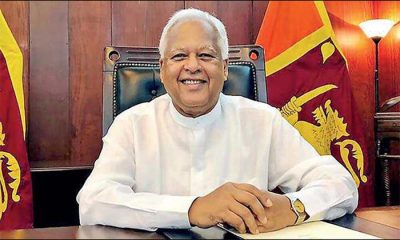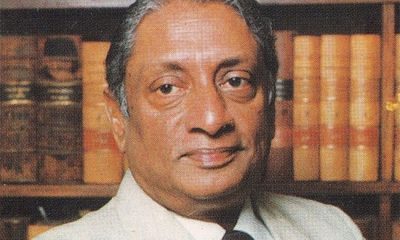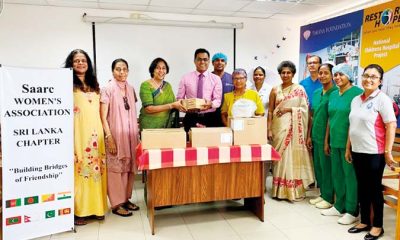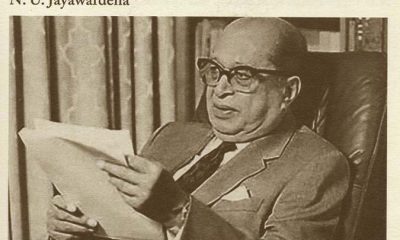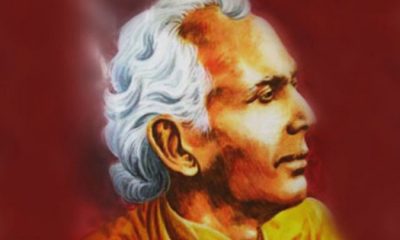Features
Back in Colombo, Indo-Lanka relations and JRJ making friends with Rajiv Gandhi
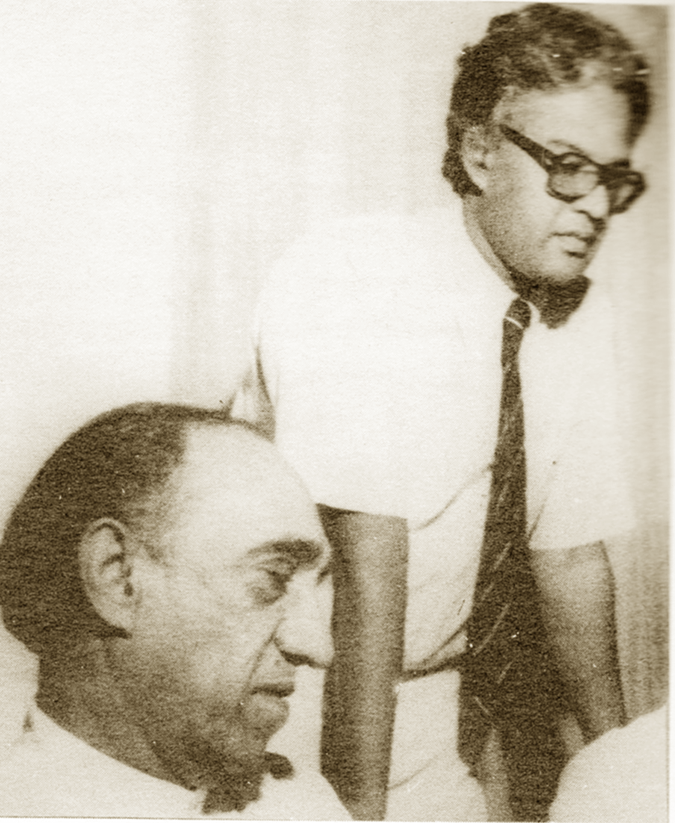
Dixit factor, Lakshman Kadirgamar and Bangalore SAARC Summit
(Excerpted from volume ii of the Sarath Amunugama autobiography)
My far-reaching decision to come back to Sri Lanka entailed making several changes regarding personal affairs. Once again my family was to be broken up with my wife and children remaining in Paris. When I told JRJ and Gamini Dissanayake of this dilemma, JRJ directed that my wife should be employed in the Sri Lanka embassy in Paris. He asked WT Jayasinghe to effect this decision immediately.
Hameed was not happy that he was bypassed but there was nothing he could do. He contented himself by saying that this was another appointment for Harispattuwa as we were registered voters in his electorate. He had infiltrated several applicants from Harispattuwa to the foreign office and was keeping a tally of the jobs given. My wife Palika proved to be one of the best officers in the Paris office and was praised for her services by Anura Bandaranaike in Parliament, even though he was in the Opposition at that time.
My younger daughter Varuni suddenly decided to come back with me and she rejoined Ladies College in the University Entrance class. The elder daughter Ramanika stayed behind with her mother as she was in the final years for her Bachelor’s degree. It also meant that we had to give up the apartment in Rue Jean Daudin and move to another approved by our embassy in Rue Cambron, which was familiar territory as we had been regular patrons of the Cambodian restaurant which was next door to this new apartment.
It overlooked an Accor Hotel and many of our friends including Lester and Sumitra Pieris stayed there to be in close proximity to our apartment. There was the usual hassles with the FO which resented my wife an ‘outsider’ being in charge of a mission and as usual `leaked’ information to the Opposition, but Anil Moonesinghe whom they contacted gave them short -hrift as did his leader Anura Bandaranaike. I moved back to my house in Siripa Road and Varuni entered the Ladies College boarding but came home for weekends.
Sinhala sentiments
The President was under great pressure at this time from the Sinhala majority which was indignant at the apparent inability of the Government to control the growing LTTE threat. The army which was led by commanders who were more inclined to ceremonial duties and had little or no battlefield experience in their days as subalterns could not cope with the situation developing in the north where the India trained guerillas of the LTTE were able to strike at will.
To make matters worse the refugees from July 1983 were not only strengthening the fighting force of the Tamils but also intervening in the West to hasten arms procurement and weapons training for the LTTE. Douglas Devananda told me many years later that their London contacts with the PLO helped them to train with the George Habash group in Lebanon
Two new developments boded ill for our security forces and JRJ. One was the expansion of the battleground to the Eastern province, leading to the depopulation of the area by the Sinhalese and Muslims. A reign of terror was unleashed against the Sinhala and Muslims so that the Tamils who were not in the majority could dominate the province militarily. Our armed forces were pushed to a situation where they could not hold the North and East simultaneously. When pressed in the North the LTTE could summon their eastern cadres to come to their rescue.
The second distressing development was the escalating attacks on innocent civilians who lived in land settlement schemes and buffer areas between Sinhalese and Tamils. These developments dented JRJs image among the Sinhalese and Muslims. It was reflected in the growing feeling among UNP parliamentarians that they should align themselves with hard liners on this issue, like the PM and Athulathmudali.
Unlike in his first term, JRJ felt that such undercurrents were at work if not against him and his advisors, it least in seeking alternative paths to satisfy their voters who were being subjected to a barrage of anti Tamil propaganda by the Sinhala media. JRJ was not a man to be easily cowed but he now had to use all his experience to attempt to control the situation which was fast deteriorating. Having met and liked Rajiv during his visit to New Delhi for the Independence commemoration, he was looking forward to his ‘tete a tete’ with the Indian PM in Bangalore in November at the SAARC meeting of 1986.
Oxford
The forthcoming meeting of SAARC attracted considerable interest not only in the region but also among political scientists worldwide. When in Paris I received an invitation from a study group in Oxford University to represent Sri Lanka at a seminar held in St Catherine’s. Scholars from the South Asian region either researching at Oxford or in ‘think tanks’ in their own countries were invited for a two-day seminar on SAARC.
My invitation came because in India, and perhaps in the other SAARC countries, my involvement in the negotiations was beginning to be known. I and my wife were housed in a pension near the College and we had dinner with Richard Gombrich and his Bengali wife Sumjukta who herself was a notable scholar. Off the seminar I met several young students from Sri Lanka including Saman Kelegama who took us for cakes and tea at the famous bookshops in town.
Much of the discussion in Oxford revolved round the changes in policy, particularly foreign policy, initiated by Rajiv Gandhi. All agreed that unlike other regional organizations like ASEAN and the EU where member states were evenly balanced, India dominated SAARC in population, economic growth and military might. Thus attention had to be drawn to India’s ‘hub status’ in discussing SAARC. The Oxford meeting was a good opportunity to understand the changes underway in India and I was dismayed to find that our foreign policy establishment did not analyze the nuances of this transformation.
On the other hand, since JRJ had taken personal control of directing foreign policy without much input from our foreign service, a wider understanding of India’s concerns was not forthcoming since many of the Indian criticisms tended to focus on JRJ’s personal predilections and intervention. His reading of the role of the US and pro-US countries like Pakistan and Israel in the region was the very issue that was being highlighted in New Delhi. These widening gaps in perceptions which were not properly analyzed at that time, became clearer with the arrival of the new Indian High Commissioner Mani Dixit in 1986 in Colombo with instructions from Rajiv Gandhi himself.
Mani Dixit
It was during the worst period of Indo-Lankan misunderstandings that Mani Dixit, who was considered to be a tough Foreign Service officer, arrived in Colombo. He had previously served in `hot spots’ like Afghanistan and Pakistan and was sent to negotiate the new Rajiv policy towards Sri Lanka. He had a reputation an official who acted as a pro-consul in the countries he served in. I was one of the very few Sri Lankans who knew Dixit before he was assigned to Colombo. He and Kaul were the two senior Foreign Service officials who served in the Indian delegation led by Parathsarathy to the IPDC (International Programme for Development Communications).
Dixit was a hard working but brusque diplomat who was totally committed to achieving Indian objectives. His aggression was perhaps a reaction to his small stature. Though he was a Dixit by virtue of his mother’s second marriage, Mani was actually a south Indian, a fact which may have been used by Delhi to allay Tamil fears that with the departure of Parathasarathy and Venkateshwaran they were losing their winning cards.
In his book `Assignment Colombo’ Dixit writes that JRJ asked him to discuss the modalities of the Indo-Lanka agreement with Gamini Dissanayake and his ‘intellectual friend Amunugama’ which shows that the President was ready for a more conciliatory approach to India. Dixit who had been a journalist, has written, after retirement, about the rights and wrongs of the Indian intervention, or from our point of view interference, in the affairs of Sri Lanka which had such dire consequences for JRJ and indeed the future of Sri Lanka as a nation.
Let us look at Dixit’s version of the events that led India into her ‘Lanka adventure’ which even today has a bearing on how Sri Lankans view our giant neighbor. According to Dixit, who summed up the situation many years later, India was concerned mostly with the geo-political implications of JRJ’s foreign policy. He says “The rise of Tamil militancy in Sri Lanka and the Jayewardene government’s serious apprehensions about this development were utilized by the US and Pakistan to create a politico-strategic pressure point in the island’s strategically sensitive coast, off the peninsula of India. Jayewardene who was apprehensive of support from Tamil Nadu to Sri Lankan Tamils was personally averse to Mrs. Gandhi and was of the view that she could not control the Indian Tamil support to Sri Lankan Tamils. He established substantive defensive and intelligence contacts with the US, Pakistan and Israel”.
Looking back, this perception which was only partly true as JRJ never underestimated the role of India, and was indeed anxious to mend fences, is an indictment of the external relations capability of small Sri Lanka which should have had the capacity to clarify matters and put good relations back on track. In fact the support of the US et al referred to by Dixit was not sufficient to counter the hegemony of India leading ‘to the pathetic isolation of Sri Lanka. All those traditions of our foreign service which always looked on India with suspicion and wanted to outwit them was coming home to roost making JRJ, and the country, highly vulnerable.
All the tall talk about `containing India’ among our chattering classes was leading the country to disaster and eventual ruin. It was only the brilliance and taking of command later by Lakshman Kadirgamar that brought realism into our foreign office and banished the ‘second rate’ Kautilyas from the decision-making scene. Let us look at the other factors that had a bearing on the conflict as seen by the Indian Mandarins.
“There was the perception that if India did not support the Tamil cause in Sri Lanka and if the Government of India tried to question the political and emotional feelings of Sri Lankan Tamils, there would be a resurgence of Tamil separatism in India”. Dixit states that India did not contemplate `a break up of Sri Lanka. If India were to endorse the claim for the establishment of a separate state on the basis of ethnicity and religion causing disintegration of a neighbouring multi ethnic multi-religious and multi-lingual state, then India would find it difficult to maintain its overall unity and territorial integrity when facing the challenges of separatism in Punjab and Kashmir.”
The riots of 1983 added another dimension to India’s relations with JRJ. The anti Tamil riots of 1983 and the Sri Lankan government’s draconian response to the violence, resulting in a large number of refugees coming to India changed the content of Indian policies towards Sri Lanka. Tamil militancy received support from both Tamil Nadu and the Central Government’
Bangalore
It was in this background that JRJ prepared himself to leave for the SAARC summit in Bangalore which was held November 1986. There was much drama at this meeting which I can describe now as I was personally present as a part of JRJ’s entourage. With the President’s permission I left for New Delhi with Anura Goonesekere, the Director of Information, about a week prior to JR’s arrival in Bangalore. My plan was to lobby the media and other vital contacts so that JRJ who had many difficulties with the negotiations up to now, would get a favourable coverage.
Back in Colombo,
My main contacts were Dilip Padgoankar who by this time had been co-opted to Rajiv’s inner circle and Biki Oberoi who was a mover and shaker in the Indian capital. We were lodged in the Oberoi Intercontinental where we also met Miss Chibb who worked there. She was the daughter of Chibb who was an advisor to the Ceylon Tourist Board in the early days when JRJ was the Minister of Tourism. The Chibb family were great admirers of our President and were drafted by me to help in my campaign to `win friends and influence people’ in the Indian capital.
I can also now reveal that Miss Chibb had been wooed many years ago by Lalith Athulathmudali. Later when I mentioned our meeting to Lalith, he told me that as an Oxford undergraduate he had pursued her all over Europe and India. It was a characteristic of Lalith that he would relentlessly pursue his objective at whatever cost.
Biki and his brother-in-law Gautam Khanna immediately made a grand gesture. The Bangalore Oberoi was completed but had not been declared open. The Oberoi family decided that in the light of JRJ’s arrival they should open the hotel immediately and offer the best suite to our President. When the President and Mrs. JRJ arrived in Bangalore they were taken to the Oberoi hotel where the whole reception area was bedecked with red roses in honour of the Sri Lankan couple. JRJ was much moved by this gesture but I remember he was distracted by his wife’s illness during their stay in Bangalore. He had to interrupt his negotiations to go to his wife’s bedside from time to time. It was then that I saw the depth of love and concern that he had for his wife.
The Bangalore meeting was crucial in the light of subsequent events and needs to be described by me as a bystander. Firstly, the opening session was a great triumph for JRJ. He had crafted his speech carefully for Rajiv’s ears. He dwelt at length on his love of India and his memories of Nehru and his fellow Congress leaders during the pre-Independence era. He clearly established himself as the senior politician in SAARC, a position that the other members of the group who were wary of Indian intentions regarding their own countries, were more than happy to acknowledge.
I saw with my own eyes the deference that other leaders, including Rajiv, showed to the old man. As the host Rajiv was solicitous of JRJ’s energy levels and would get up to help him to stand and sit, which was keenly observed by the Indian bureaucrats who as mentioned earlier were apprehensive that a rapport between the two would undermine their Pro-Tamil initiatives. That was exactly what happened, and the two leaders established a trust which was seen in the crucial ‘behind the scenes’ activities that now became the main concern.
Features
The heart-friendly health minister

by Dr Gotabhya Ranasinghe
Senior Consultant Cardiologist
National Hospital Sri Lanka
When we sought a meeting with Hon Dr. Ramesh Pathirana, Minister of Health, he graciously cleared his busy schedule to accommodate us. Renowned for his attentive listening and deep understanding, Minister Pathirana is dedicated to advancing the health sector. His openness and transparency exemplify the qualities of an exemplary politician and minister.
Dr. Palitha Mahipala, the current Health Secretary, demonstrates both commendable enthusiasm and unwavering support. This combination of attributes makes him a highly compatible colleague for the esteemed Minister of Health.
Our discussion centered on a project that has been in the works for the past 30 years, one that no other minister had managed to advance.
Minister Pathirana, however, recognized the project’s significance and its potential to revolutionize care for heart patients.
The project involves the construction of a state-of-the-art facility at the premises of the National Hospital Colombo. The project’s location within the premises of the National Hospital underscores its importance and relevance to the healthcare infrastructure of the nation.
This facility will include a cardiology building and a tertiary care center, equipped with the latest technology to handle and treat all types of heart-related conditions and surgeries.
Securing funding was a major milestone for this initiative. Minister Pathirana successfully obtained approval for a $40 billion loan from the Asian Development Bank. With the funding in place, the foundation stone is scheduled to be laid in September this year, and construction will begin in January 2025.
This project guarantees a consistent and uninterrupted supply of stents and related medications for heart patients. As a result, patients will have timely access to essential medical supplies during their treatment and recovery. By securing these critical resources, the project aims to enhance patient outcomes, minimize treatment delays, and maintain the highest standards of cardiac care.
Upon its fruition, this monumental building will serve as a beacon of hope and healing, symbolizing the unwavering dedication to improving patient outcomes and fostering a healthier society.We anticipate a future marked by significant progress and positive outcomes in Sri Lanka’s cardiovascular treatment landscape within the foreseeable timeframe.
Features
A LOVING TRIBUTE TO JESUIT FR. ALOYSIUS PIERIS ON HIS 90th BIRTHDAY

by Fr. Emmanuel Fernando, OMI
Jesuit Fr. Aloysius Pieris (affectionately called Fr. Aloy) celebrated his 90th birthday on April 9, 2024 and I, as the editor of our Oblate Journal, THE MISSIONARY OBLATE had gone to press by that time. Immediately I decided to publish an article, appreciating the untiring selfless services he continues to offer for inter-Faith dialogue, the renewal of the Catholic Church, his concern for the poor and the suffering Sri Lankan masses and to me, the present writer.
It was in 1988, when I was appointed Director of the Oblate Scholastics at Ampitiya by the then Oblate Provincial Fr. Anselm Silva, that I came to know Fr. Aloy more closely. Knowing well his expertise in matters spiritual, theological, Indological and pastoral, and with the collaborative spirit of my companion-formators, our Oblate Scholastics were sent to Tulana, the Research and Encounter Centre, Kelaniya, of which he is the Founder-Director, for ‘exposure-programmes’ on matters spiritual, biblical, theological and pastoral. Some of these dimensions according to my view and that of my companion-formators, were not available at the National Seminary, Ampitiya.
Ever since that time, our Oblate formators/ accompaniers at the Oblate Scholasticate, Ampitiya , have continued to send our Oblate Scholastics to Tulana Centre for deepening their insights and convictions regarding matters needed to serve the people in today’s context. Fr. Aloy also had tried very enthusiastically with the Oblate team headed by Frs. Oswald Firth and Clement Waidyasekara to begin a Theologate, directed by the Religious Congregations in Sri Lanka, for the contextual formation/ accompaniment of their members. It should very well be a desired goal of the Leaders / Provincials of the Religious Congregations.
Besides being a formator/accompanier at the Oblate Scholasticate, I was entrusted also with the task of editing and publishing our Oblate journal, ‘The Missionary Oblate’. To maintain the quality of the journal I continue to depend on Fr. Aloy for his thought-provoking and stimulating articles on Biblical Spirituality, Biblical Theology and Ecclesiology. I am very grateful to him for his generous assistance. Of late, his writings on renewal of the Church, initiated by Pope St. John XX111 and continued by Pope Francis through the Synodal path, published in our Oblate journal, enable our readers to focus their attention also on the needed renewal in the Catholic Church in Sri Lanka. Fr. Aloy appreciated very much the Synodal path adopted by the Jesuit Pope Francis for the renewal of the Church, rooted very much on prayerful discernment. In my Religious and presbyteral life, Fr.Aloy continues to be my spiritual animator / guide and ongoing formator / acccompanier.
Fr. Aloysius Pieris, BA Hons (Lond), LPh (SHC, India), STL (PFT, Naples), PhD (SLU/VC), ThD (Tilburg), D.Ltt (KU), has been one of the eminent Asian theologians well recognized internationally and one who has lectured and held visiting chairs in many universities both in the West and in the East. Many members of Religious Congregations from Asian countries have benefited from his lectures and guidance in the East Asian Pastoral Institute (EAPI) in Manila, Philippines. He had been a Theologian consulted by the Federation of Asian Bishops’ Conferences for many years. During his professorship at the Gregorian University in Rome, he was called to be a member of a special group of advisers on other religions consulted by Pope Paul VI.
Fr. Aloy is the author of more than 30 books and well over 500 Research Papers. Some of his books and articles have been translated and published in several countries. Among those books, one can find the following: 1) The Genesis of an Asian Theology of Liberation (An Autobiographical Excursus on the Art of Theologising in Asia, 2) An Asian Theology of Liberation, 3) Providential Timeliness of Vatican 11 (a long-overdue halt to a scandalous millennium, 4) Give Vatican 11 a chance, 5) Leadership in the Church, 6) Relishing our faith in working for justice (Themes for study and discussion), 7) A Message meant mainly, not exclusively for Jesuits (Background information necessary for helping Francis renew the Church), 8) Lent in Lanka (Reflections and Resolutions, 9) Love meets wisdom (A Christian Experience of Buddhism, 10) Fire and Water 11) God’s Reign for God’s poor, 12) Our Unhiddden Agenda (How we Jesuits work, pray and form our men). He is also the Editor of two journals, Vagdevi, Journal of Religious Reflection and Dialogue, New Series.
Fr. Aloy has a BA in Pali and Sanskrit from the University of London and a Ph.D in Buddhist Philosophy from the University of Sri Lankan, Vidyodaya Campus. On Nov. 23, 2019, he was awarded the prestigious honorary Doctorate of Literature (D.Litt) by the Chancellor of the University of Kelaniya, the Most Venerable Welamitiyawe Dharmakirthi Sri Kusala Dhamma Thera.
Fr. Aloy continues to be a promoter of Gospel values and virtues. Justice as a constitutive dimension of love and social concern for the downtrodden masses are very much noted in his life and work. He had very much appreciated the commitment of the late Fr. Joseph (Joe) Fernando, the National Director of the Social and Economic Centre (SEDEC) for the poor.
In Sri Lanka, a few religious Congregations – the Good Shepherd Sisters, the Christian Brothers, the Marist Brothers and the Oblates – have invited him to animate their members especially during their Provincial Congresses, Chapters and International Conferences. The mainline Christian Churches also have sought his advice and followed his seminars. I, for one, regret very much, that the Sri Lankan authorities of the Catholic Church –today’s Hierarchy—- have not sought Fr.
Aloy’s expertise for the renewal of the Catholic Church in Sri Lanka and thus have not benefited from the immense store of wisdom and insight that he can offer to our local Church while the Sri Lankan bishops who governed the Catholic church in the immediate aftermath of the Second Vatican Council (Edmund Fernando OMI, Anthony de Saram, Leo Nanayakkara OSB, Frank Marcus Fernando, Paul Perera,) visited him and consulted him on many matters. Among the Tamil Bishops, Bishop Rayappu Joseph was keeping close contact with him and Bishop J. Deogupillai hosted him and his team visiting him after the horrible Black July massacre of Tamils.
Features
A fairy tale, success or debacle

Sri Lanka-Singapore Free Trade Agreement
By Gomi Senadhira
senadhiragomi@gmail.com
“You might tell fairy tales, but the progress of a country cannot be achieved through such narratives. A country cannot be developed by making false promises. The country moved backward because of the electoral promises made by political parties throughout time. We have witnessed that the ultimate result of this is the country becoming bankrupt. Unfortunately, many segments of the population have not come to realize this yet.” – President Ranil Wickremesinghe, 2024 Budget speech
Any Sri Lankan would agree with the above words of President Wickremesinghe on the false promises our politicians and officials make and the fairy tales they narrate which bankrupted this country. So, to understand this, let’s look at one such fairy tale with lots of false promises; Ranil Wickremesinghe’s greatest achievement in the area of international trade and investment promotion during the Yahapalana period, Sri Lanka-Singapore Free Trade Agreement (SLSFTA).
It is appropriate and timely to do it now as Finance Minister Wickremesinghe has just presented to parliament a bill on the National Policy on Economic Transformation which includes the establishment of an Office for International Trade and the Sri Lanka Institute of Economics and International Trade.
Was SLSFTA a “Cleverly negotiated Free Trade Agreement” as stated by the (former) Minister of Development Strategies and International Trade Malik Samarawickrama during the Parliamentary Debate on the SLSFTA in July 2018, or a colossal blunder covered up with lies, false promises, and fairy tales? After SLSFTA was signed there were a number of fairy tales published on this agreement by the Ministry of Development Strategies and International, Institute of Policy Studies, and others.
However, for this article, I would like to limit my comments to the speech by Minister Samarawickrama during the Parliamentary Debate, and the two most important areas in the agreement which were covered up with lies, fairy tales, and false promises, namely: revenue loss for Sri Lanka and Investment from Singapore. On the other important area, “Waste products dumping” I do not want to comment here as I have written extensively on the issue.
1. The revenue loss
During the Parliamentary Debate in July 2018, Minister Samarawickrama stated “…. let me reiterate that this FTA with Singapore has been very cleverly negotiated by us…. The liberalisation programme under this FTA has been carefully designed to have the least impact on domestic industry and revenue collection. We have included all revenue sensitive items in the negative list of items which will not be subject to removal of tariff. Therefore, 97.8% revenue from Customs duty is protected. Our tariff liberalisation will take place over a period of 12-15 years! In fact, the revenue earned through tariffs on goods imported from Singapore last year was Rs. 35 billion.
The revenue loss for over the next 15 years due to the FTA is only Rs. 733 million– which when annualised, on average, is just Rs. 51 million. That is just 0.14% per year! So anyone who claims the Singapore FTA causes revenue loss to the Government cannot do basic arithmetic! Mr. Speaker, in conclusion, I call on my fellow members of this House – don’t mislead the public with baseless criticism that is not grounded in facts. Don’t look at petty politics and use these issues for your own political survival.”
I was surprised to read the minister’s speech because an article published in January 2018 in “The Straits Times“, based on information released by the Singaporean Negotiators stated, “…. With the FTA, tariff savings for Singapore exports are estimated to hit $10 million annually“.
As the annual tariff savings (that is the revenue loss for Sri Lanka) calculated by the Singaporean Negotiators, Singaporean $ 10 million (Sri Lankan rupees 1,200 million in 2018) was way above the rupees’ 733 million revenue loss for 15 years estimated by the Sri Lankan negotiators, it was clear to any observer that one of the parties to the agreement had not done the basic arithmetic!
Six years later, according to a report published by “The Morning” newspaper, speaking at the Committee on Public Finance (COPF) on 7th May 2024, Mr Samarawickrama’s chief trade negotiator K.J. Weerasinghehad had admitted “…. that forecasted revenue loss for the Government of Sri Lanka through the Singapore FTA is Rs. 450 million in 2023 and Rs. 1.3 billion in 2024.”
If these numbers are correct, as tariff liberalisation under the SLSFTA has just started, we will pass Rs 2 billion very soon. Then, the question is how Sri Lanka’s trade negotiators made such a colossal blunder. Didn’t they do their basic arithmetic? If they didn’t know how to do basic arithmetic they should have at least done their basic readings. For example, the headline of the article published in The Straits Times in January 2018 was “Singapore, Sri Lanka sign FTA, annual savings of $10m expected”.
Anyway, as Sri Lanka’s chief negotiator reiterated at the COPF meeting that “…. since 99% of the tariffs in Singapore have zero rates of duty, Sri Lanka has agreed on 80% tariff liberalisation over a period of 15 years while expecting Singapore investments to address the imbalance in trade,” let’s turn towards investment.
Investment from Singapore
In July 2018, speaking during the Parliamentary Debate on the FTA this is what Minister Malik Samarawickrama stated on investment from Singapore, “Already, thanks to this FTA, in just the past two-and-a-half months since the agreement came into effect we have received a proposal from Singapore for investment amounting to $ 14.8 billion in an oil refinery for export of petroleum products. In addition, we have proposals for a steel manufacturing plant for exports ($ 1 billion investment), flour milling plant ($ 50 million), sugar refinery ($ 200 million). This adds up to more than $ 16.05 billion in the pipeline on these projects alone.
And all of these projects will create thousands of more jobs for our people. In principle approval has already been granted by the BOI and the investors are awaiting the release of land the environmental approvals to commence the project.
I request the Opposition and those with vested interests to change their narrow-minded thinking and join us to develop our country. We must always look at what is best for the whole community, not just the few who may oppose. We owe it to our people to courageously take decisions that will change their lives for the better.”
According to the media report I quoted earlier, speaking at the Committee on Public Finance (COPF) Chief Negotiator Weerasinghe has admitted that Sri Lanka was not happy with overall Singapore investments that have come in the past few years in return for the trade liberalisation under the Singapore-Sri Lanka Free Trade Agreement. He has added that between 2021 and 2023 the total investment from Singapore had been around $162 million!
What happened to those projects worth $16 billion negotiated, thanks to the SLSFTA, in just the two-and-a-half months after the agreement came into effect and approved by the BOI? I do not know about the steel manufacturing plant for exports ($ 1 billion investment), flour milling plant ($ 50 million) and sugar refinery ($ 200 million).
However, story of the multibillion-dollar investment in the Petroleum Refinery unfolded in a manner that would qualify it as the best fairy tale with false promises presented by our politicians and the officials, prior to 2019 elections.
Though many Sri Lankans got to know, through the media which repeatedly highlighted a plethora of issues surrounding the project and the questionable credentials of the Singaporean investor, the construction work on the Mirrijiwela Oil Refinery along with the cement factory began on the24th of March 2019 with a bang and Minister Ranil Wickremesinghe and his ministers along with the foreign and local dignitaries laid the foundation stones.
That was few months before the 2019 Presidential elections. Inaugurating the construction work Prime Minister Ranil Wickremesinghe said the projects will create thousands of job opportunities in the area and surrounding districts.
The oil refinery, which was to be built over 200 acres of land, with the capacity to refine 200,000 barrels of crude oil per day, was to generate US$7 billion of exports and create 1,500 direct and 3,000 indirect jobs. The construction of the refinery was to be completed in 44 months. Four years later, in August 2023 the Cabinet of Ministers approved the proposal presented by President Ranil Wickremesinghe to cancel the agreement with the investors of the refinery as the project has not been implemented! Can they explain to the country how much money was wasted to produce that fairy tale?
It is obvious that the President, ministers, and officials had made huge blunders and had deliberately misled the public and the parliament on the revenue loss and potential investment from SLSFTA with fairy tales and false promises.
As the president himself said, a country cannot be developed by making false promises or with fairy tales and these false promises and fairy tales had bankrupted the country. “Unfortunately, many segments of the population have not come to realize this yet”.
(The writer, a specialist and an activist on trade and development issues . )


